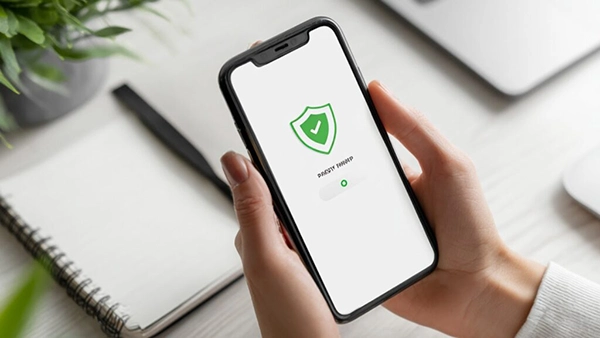Did you know? In 2024, mobile proxies accounted for 17% of total proxy traffic, trailing residential (44%) and datacenter proxies (39%). However, demand for 4G/5G mobile proxies is growing. (Source)
In today’s hyper-connected world, the threats on the internet are also constantly growing; the need for mobile proxies has now become unavoidable.
I’ve personally found out some strategies for different devices and scenarios, and successfully achieved a reliable mobile proxy setup that actually works.
That’ why in this article I’m going to show you exactly how to set up a mobile proxy from scratch. Whether you’re managing multiple social media accounts, scraping data, or need to bypass geo-restrictions,
Let’s jump right in.
Key Takeaways
- Understanding what a mobile proxy is.
- Looking at three setup options
- Discovering some diverse methods for distinctive devices
- Decoding some advanced tricks

Think of a mobile proxy as your internet traffic bodyguard. Instead of websites seeing your real location, they see a mobile carrier’s IP address. It’s like borrowing someone else’s phone number, but for the internet.
Here’s the thing – mobile IPs are gold. Websites trust them way more than those sketchy datacenter addresses. Why? Because real people use mobile networks every day. You’re not some robot in a server farm.
I’ve tested this dozens of times. Mobile proxies get past blocks that destroy regular proxies. The success rate isn’t even close.
What you can do with mobile proxies:
Interesting Facts
Mobile proxies are ideal for large-scale data collection on websites that are sensitive to proxy usage, including competitor price monitoring and search engine optimization (SEO).
You’ve got three paths here. I’ll tell you which one I’d pick for different situations.
What you need:
Cost: Basically free if you have a spare phone
Difficulty: Super easy
Best for: Testing the waters, small projects
What you need:
Cost: $100-200 upfront
Difficulty: Medium (but I’ll walk you through it)
Best for: Serious users who want control
What you get:
Cost: $10-50+ monthly (depends on usage)
Difficulty: Dead simple
Best for: Businesses that value time over money
Honestly? For most people, a mobile proxy from Floxy makes the most sense. But let’s cover all three so you can decide.

I’m starting with this because it’s foolproof. Even my mom could do this.
Here’s what worked for Jake:
Step 1: Pull down your notification bar and hit that gear icon. Find “Wi-Fi” in settings.
Step 2: See your connected network? Tap the little “i” next to it. Look for “Proxy” and switch it to “Manual.”
Step 3: You’ll see some boxes to fill:
Step 4: Save it and test. Go to whatismyipaddress.com to check if it worked.
This one’s trickier but sometimes works better:
Step 1: Settings > Network & Internet > Mobile Network. Find “Access Point Names” and tap your carrier.
Step 2: Scroll down until you see proxy settings:
Step 3: Hit those three dots in the corner and save. Turn mobile data off and back on.
Jake’s tip: Try both methods. One might work better depending on your carrier’s setup.
This is where things get interesting. You’re building your own mobile proxy farm.
Don’t let anyone oversell you on this:
Step 1: Get the OS Running
Download Raspberry Pi OS from their official site. Use their imaging tool to flash your SD card. Boot it up and get through the basic setup.
Step 2: Install Your Proxy Software
Open a terminal and run:
bash
sudo apt update && sudo apt upgrade -y
sudo apt install squid3 -y
Step 3: Configure the Modem
Stick your SIM in the USB modem and plug it into the Pi. Most modern modems work automatically, but you might need to set up APN settings for your carrier.
Step 4: Set Up Squid
Edit the config file:
bash
sudo nano /etc/squid/squid.conf
Add these lines:
http_port 3128
http_access allow all
forwarded_for off
Start it up:
bash
sudo systemctl enable squid
sudo systemctl start squid
Step 5: Test Everything
Set your proxy from another device to your Pi’s IP address at port 3128. Check your IP address – it should now display your mobile carrier.
Location matters: Put your Pi somewhere with good cell coverage. I learned this the hard way when Jake’s first setup kept dropping connections.
Monitor data usage: Carriers get suspicious if you blow through terabytes. Keep it reasonable.
Have backups: SIM cards die. Modems break. Always have spares.
Sometimes you just want stuff to work without the headaches. That’s where Floxy shines.
I’ve tested dozens of proxy services. Most are garbage. They are different because they use real mobile device connections, not some sketchy simulation.
Real benefits I’ve seen:
Step 1: Pick Your Plan
Go to their mobile proxy page. Plans start around $0.13 per IP daily. Choose based on how much data you’ll push through.
Step 2: Get Your Access Details
After buying, you’ll receive:
Step 3: Configure Your Software
For browsers, just punch in the proxy details in your network settings.
For automation, here’s Python code that works:
python
import requests
proxy_config = {
‘http’: ‘http://user:pass@proxy.floxy.io:port’,
‘https’: ‘https://user:pass@proxy.floxy.io:port’
}
response = requests.get(‘http://httpbin.org/ip’, proxies=proxy_config)
print(response.json())
Step 4: Monitor and Optimize
Use their dashboard to track usage and switch countries when needed.
Once you’ve got the basics working, these tweaks make a huge difference.
Time-based: Every 15-20 minutes, change IP addresses. It appears natural and avoids patterns.
Each task or account is assigned a new IP address during the session. It keeps things separated.
Geographic: Rotate between nearby cities, not random countries.
Connection reuse: Don’t establish new connections for every request.
Request timing: Add 1-3 second delays between requests. Bots go fast, humans don’t.
User agent rotation: Match your IP changes with realistic mobile user agents.
HTTPS everywhere: Even with proxies, encrypt your traffic.
Realistic patterns: Browse like a human would. Random clicks, pauses, scrolls.
Monitor for leaks: Check for IP, DNS, and WebRTC leaks regularly.

Every setup has issues. Here’s how to fix the ones I see most.
Problem: Proxy won’t connect
Fix checklist:
Problem: Everything loads like dial-up
Solutions:
Problem: Websites detect and block your proxy
What works:
Let me give you real numbers so you can budget properly.
For most business use cases, professional services win on total cost when you include your time.
Here’s where mobile proxies actually make money or solve problems.
Jake uses his setup to track competitor prices across different regions. Mobile IPs don’t trigger anti-bot systems like datacenter proxies do.
Agencies run dozens of client accounts from various mobile IP addresses. Each account is assigned a unique and consistent location.
Collecting public data from review sites, forums, and social platforms without getting rate-limited.
Making sure your ads display correctly in different countries using authentic mobile connections.
Mobile proxies are legal tools, but how you use them matters.
Generally okay:
Avoid these:
Smart practices:
Based on hundreds of setups I’ve seen:
Go DIY Android if:
Build a Raspberry Pi setup if:
Choose Floxy if:
For moUptime and support are important. make the most sense. But I wanted you to understand all your options.
Pick your method and just start. Perfection kills progress.
If you’re going DIY, grab that old Android phone and follow the Wi-Fi setup steps. Takes 20 minutes, and you’ll know if mobile proxies solve your problem.
Sign up for Floxy and try out their services for business. Their trial options allow you to validate everything before committing to a significant investment.
The mobile proxy landscape is constantly shifting. 5G networks are improving in speed. Geographic targeting is becoming more precise. Integration tools are improving.
But the fundamentals stay the same: mobile IPs provide better access and lower detection rates than any other proxy type.
Mobile proxies are used for tasks that require a high level of legitimacy, such as social media management, ad verification, and web scraping.
Yes, they are legal, as long as they are used ethically and in compliance with local regulations.
Primarily, it acts as a gateway between you and the internet.
